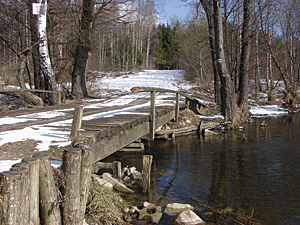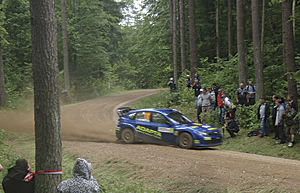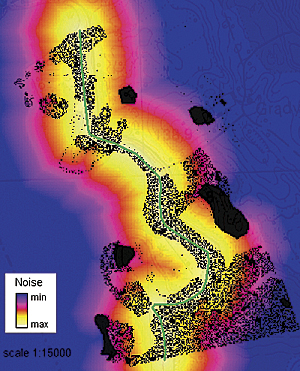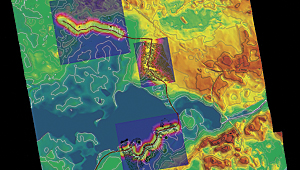Does Rally Poland Leave Kruklin Forest Like It Found It?
An Environmental Impact Assessment of the Event
By Michal Zugajewicz, Director, Enviro Solutions
Highlights
- Environmental impact of the rally was assessed with GIS.
- 3D visualization based on a digital terrain model and digital surface model were created with ArcGIS.
- The data terrain model was presented using anaglyphs (stereo view projection mode), creating a 3D illusion and increasing visual realism.
Started in 1921, Rally Poland is the second-oldest car rally in the world after the Monte Carlo Rally. The original event "traveled" from the Cracov region to Klodzko Valley, Carpathia, Lower Silesia, and Wroclaw and finally to Mikolajki, between Talty Lake and Mikolajki Lake. Nowadays, the rally delights spectators and participants with its beautiful scenery, including vast lakes, mainly coniferous forests, blooming meadows, and natural channels intersected by narrow wooden bridges.

Section of the rally located along Kruklin Lake on a narrow wooden bridge.
Because Rally Poland takes place in one of the most picturesque Polish regions—Masuria—analyses were performed to assess its impact on the environment. Several factors were measured: noise levels (which may disturb forest animals), contamination from heavy metals (from car fumes) in the trees, influence on the infrastructure, and fans' impact on the forest and its surroundings circling Kruklin Lake.
Most measurements were collected using professional instruments (e.g., sonometer). The amount of CO2 emission was taken from the cars' manufacturers, while the content of harmful elements in pine (Pinus sylvestris) needles was analyzed in laboratory tests. Because Rally Poland and its impact on the natural environment have spatial dimensions, GIS was used to perform spatial data analyses.
To check how the rally influences the environment in different areas, three sectors were defined: open area, deep forest, and around the lake. The data prepared beforehand was used to create layers containing information related to land cover. These included such objects as the forest, single trees, buildings, hillocks, roads, and forest vistas.
To analyze noise dispersion, all elements mentioned above were joined using the Raster Calculator in ArcGIS, allowing them to be treated as barrier objects for each particular sector. Next, values of the noise transmission (permeability) for buildings, trees, and hillocks were assigned, and using the Cost Distance option, the spread of noise was determined. Additionally, a special acoustic application, HPZ'2001, was implemented to create three buffer ranges—98 dB (source), 60 dB (limit for farm housing areas), and 55 dB (limit for single-family housing areas)—all on the basemap of the aerial photographs.
Such calculations helped determine places where increased noise could frighten wild animals, including deer, roe deer, boars, hares, foxes, beavers, and even lynxes, as well as disturb forest birds and their nestlings. Additionally, using a buffer tool, ranges of fume emission (based on noise dispersion) for each of the three sectors were generated.
ArcGIS was also used to check which regions of each area of interest assimilation and photosynthesis rates are likely to be higher due to solar illumination. For these purposes, aspects were calculated. Such analyses helped show where the sun possibly shines stronger and determine the areas of higher assimilation rates. Because the sun's effects are strongest in the south, southeast, and southwest, such locations of trees on the surface were selected and delineated.
Rally cars are not the only source of environmental hazards. Motorsport fans are also an integral part of rallies and, unfortunately, sometimes pose a risk. Their activities may be associated with destruction of undergrowth, breaking tree branches, dropping litter in the forest, animal disturbance, trampling cornfields, and so on. But the most dangerous threat is starting a fire.

Rally car in action in Kruklin Forest.
Based on rally folders, brochures, and observation, points were defined showing places of high fire risk. Usually, these are locations of large clusters of fans, where cigarette butts, barbecues, and campfires can be situated. To determine ranges of the fire risk, the multiple buffer ring tool was used. Because fan sectors are oblong and rather narrow, three distance ranges (buffer rings) from the fire sources were defined with values of 20, 40, and 60 meters. This distance is probably the maximum range of fire spread coming from the grills, small fireplaces, and cigarette butts during the rally. At the end, single points from the layers representing forest were converted to polygons using an ET Geowizards tool. They were then changed into three-dimensional data using an extrusion process. Finally, the buffer layer was applied to forest layers to illustrate places with the potential for fire.
Apart from the risk calculations, other issues were also researched. For instance, it was important to analyze areas convenient for fans to observe the rally. Some rally stages are rich in steep hills, called rally jumps. Such places are the favorite observation points of most fans. To determine visibility of the road from observation points, line-of-sight and viewshed tools were used. These provide a quick and simple answer to the questions, Will I see my favorite driver in action from that place? and If not, where is it best to go?

Result of the noise dispersion analysis of one of three assigned sections of the Kozuchy male rally stage.
To show all analyzed phenomena from different perspectives, as well as in a more realistic way, the author created a 3D visualization based on a digital terrain model and digital surface model. Using ArcGIS, several kinds of textures, representing various tree species, buildings, and rally fans, were applied to the model. Then, layers presenting results of each analysis were added to the project, and everything was placed together on the scanned map and aerial basemaps. Finally, the model was presented using anaglyphs (stereo view projection mode), which created a 3D illusion, increasing visual realism. The author used ArcGIS to present an interactive tour through the analyzed rally sections, simulating the sports car races and seeing how they affect the environment surrounding the rally route.
About the Author
Michal Zugajewicz is director of Enviro Solutions and a specialist in information technology applications in forestry and the environment. He is also a graduate of the International Masters Study Program in Forest Information Technology at the University of Applied Sciences in Eberswalde, Germany, and the Warsaw University of Life Sciences (Poland), as well as a 2010 winner of Esri international distributor ESRI Polska sp. z o.o.'s contest for the best thesis promoting GIS.
For more information, contact Michal Zugajewicz, director, Enviro Solutions (e-mail: office@envirosolutions.pl, tel.: 0048-501-540-755), or visit www.envirosolutions.pl.
